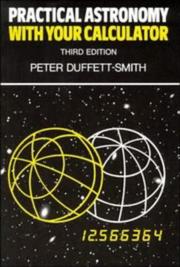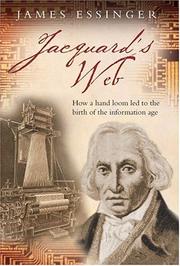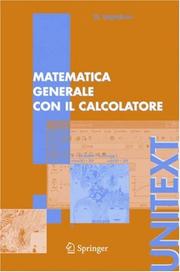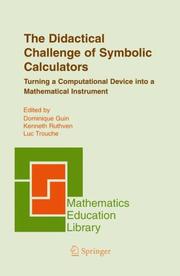| Listing 1 - 5 of 5 |
Sort by
|

ISBN: 0511251688 1139930060 1139929445 0511337558 0511336942 0511336292 0511338112 0511564899 9780511338113 9780511564895 0521356296 9780521356299 0521356997 9780521356992 9780511251689 9781139930062 9781139929448 9780511337550 9780511336942 9780511336294 Year: 1988 Publisher: Cambridge : Cambridge University Press,
Abstract | Keywords | Export | Availability | Bookmark
 Loading...
Loading...Choose an application
- Reference Manager
- EndNote
- RefWorks (Direct export to RefWorks)
Practical Astronomy with your Calculator, first published in 1979, has enjoyed immense success. The author's clear and easy to follow routines enable you to solve a variety of practical and recreational problems in astronomy using a scientific calculator. Mathematical complexity is kept firmly in the background, leaving just the elements necessary for swiftly making calculations. The major topics are: time, coordinate systems, the Sun, the planetary system, binary stars, the Moon, and eclipses. In the third edition there are entirely new sections on generalised coordinate transformations, nutrition, aberration, and selenographic coordinates. The calculations for sunrise and moonrise are improved. A larger page size has increased the clarity of the presentation. This handbook is essential for anyone who needs to make astronomical calculations. It will be enjoyed by amateur astronomers and appreciated by students studying introductory astronomy. • Clear presentation • Reliable approximations • Covers orbits, transformations, and general celestial phenomena • Can be used anywhere, worldwide • Routines extensively tested by thousands of readers round the world
Astronomy --- Calculators. --- Adding-machines --- Calculating-machines --- Computers, Mechanical --- Desk calculators --- Mathematical machines (Calculators) --- Mechanical computers --- Mathematical instruments --- Office equipment and supplies --- Arithmetic --- Computers --- Tabulating machines

ISBN: 0192805770 1281346543 0191517259 9780191517259 9781281346544 9780192805782 0192805789 9786611346546 6611346546 9780192805775 019150114X Year: 2007 Publisher: Oxford : Oxford University Press,
Abstract | Keywords | Export | Availability | Bookmark
 Loading...
Loading...Choose an application
- Reference Manager
- EndNote
- RefWorks (Direct export to RefWorks)
Jacquard's Web tells one of the greatest untold stories of science: how a hand loom invented in Napoleonic France led to the birth of the modern computer age. James Essinger, a master storyteller, traces the 200-year evolution of Jacquard's idea from the studios of 18th century weavers, through the Industrial Revolution to the development of hi-tech computers and the information age today. - ;Jacquard's Web is the story of some of the most ingenious inventors the world has ever known, a fascinating account of how a hand-loom invented in Napoleonic France led to the development of the modern in
Computing --- Calculators. --- Jacquard knitting machines. --- Information technology --- History. --- Jacquard, Joseph-Marie, --- Adding-machines --- Calculating-machines --- Computers, Mechanical --- Desk calculators --- Mathematical machines (Calculators) --- Mechanical computers --- Jacquard, Charles-Marie, --- Jacquard knitting machines --- Jacquard, Métiers --- Jacquard, Joseph Marie --- Jacquard, Joseph Marie. --- Jacquard, Métiers --- Jacquard, Joseph Marie, --- Knitting machines --- Mathematical instruments --- Office equipment and supplies --- Arithmetic --- Computers --- Tabulating machines --- Ordinateurs --- Technologie de l'information --- Histoire

ISBN: 8847002583 8847003458 Year: 2005 Publisher: Milano : Springer Milan : Imprint: Springer,
Abstract | Keywords | Export | Availability | Bookmark
 Loading...
Loading...Choose an application
- Reference Manager
- EndNote
- RefWorks (Direct export to RefWorks)
Questo libro è nato dall'esperienza del corso di Matematica Generale all'Università Bocconi. Nel presentare gli oggetti matematici insegna allo studente l'utilizzo del calcolatore per svolgere calcolo numerico e calcolo simbolico, definire una funzione e calcolarne i valori, tracciare ed esplorare grafici, eseguire semplici algoritmi.La trattazione è ricca di esempi, applicazioni, modelli, tratti dal contesto economico ma anche da quello fisico, biologico, statistico e dalla stessa matematica. L'analisi di tali modelli costituisce in un certo senso il vero scopo della teoria matematica svolta.Per esplorare ed illustrare concetti e proprietà si fa largo uso di strumenti automatici di calcolo (software di Matematica, fogli elettronici). In particolare è stato utilizzato il software Mathcad®, sia come strumento di calcolo sia come semplice ma potente linguaggio di programmazione.Largo spazio è dedicato: all'approssimazione, sottolineando la distinzione tra calcolo numerico e calcolo simbolico; all'algoritmo come sintesi tra l'aspetto sintattico e quello semantico degli oggetti matematici; alla simulazione al calcolatore, interpretata come esperimento "fisico" e fonte di congetture. La possibilità di utilizzare un calcolatore sancisce una sorta di "democratizzazione" della matematica: risultati anche complessi, che hanno sempre richiesto un ampio retroterra di conoscenze e laboriosi calcoli, sono ora rapidamente raggiungibili da chiunque conosca il significato degli oggetti matematici e sappia usare la sintassi.
Mathematical Theory --- Applied Mathematics --- Engineering & Applied Sciences --- Mathematics --- Physical Sciences & Mathematics --- Mathematics. --- Calculators. --- Mathematical analysis. --- Analysis (Mathematics). --- Difference equations. --- Functional equations. --- Computer mathematics. --- Algorithms. --- Mathematics, general. --- Analysis. --- Difference and Functional Equations. --- Computational Mathematics and Numerical Analysis. --- Computational Science and Engineering. --- Math --- Science --- Adding-machines --- Calculating-machines --- Computers, Mechanical --- Desk calculators --- Mathematical machines (Calculators) --- Mechanical computers --- Mathematical instruments --- Office equipment and supplies --- Arithmetic --- Computers --- Tabulating machines --- Global analysis (Mathematics). --- Computer science --- Computer science. --- Informatics --- Algorism --- Algebra --- Computer mathematics --- Discrete mathematics --- Electronic data processing --- Equations, Functional --- Functional analysis --- Analysis, Global (Mathematics) --- Differential topology --- Functions of complex variables --- Geometry, Algebraic --- Foundations --- Calculus of differences --- Differences, Calculus of --- Equations, Difference --- 517.1 Mathematical analysis --- Mathematical analysis
Book
ISBN: 3030026191 3030026183 Year: 2018 Publisher: Cham : Springer International Publishing : Imprint: Springer,
Abstract | Keywords | Export | Availability | Bookmark
 Loading...
Loading...Choose an application
- Reference Manager
- EndNote
- RefWorks (Direct export to RefWorks)
This encyclopedic reference provides a concise and engaging overview of the groundbreaking inventions and conceptual innovations that have shaped the field of computing, and the technology that runs the modern world. Each alphabetically-ordered entry presents a brief account of a pivotal innovation and the great minds behind it, selected from a wide range of diverse topics. Topics and features: Describes the development of Babbage’s computing machines, Leibniz’s binary arithmetic, Boole’s symbolic logic, and Von Neumann architecture Reviews a range of historical analog and digital computers, significant mainframes and minicomputers, and pioneering home and personal computers Discusses a selection of programming languages and operating systems, along with key concepts in software engineering and commercial computing Examines the invention of the transistor, the integrated circuit, and the microprocessor Relates the history of such developments in personal computing as the mouse, the GUI, Atari video games, and Microsoft Office Surveys innovations in communications, covering mobile phones, WiFi, the Internet and World Wide Web, e-commerce, smartphones, social media, and GPS Presents coverage of topics on artificial intelligence, the ATM, digital photography and digital music, robotics, and Wikipedia Contains self-test quizzes and a helpful glossary This enjoyable compendium will appeal to the general reader curious about the intellectual milestones that led to the digital age, as well as to the student of computer science seeking a primer on the history of their field. Dr. Gerard O'Regan is a CMMI software process improvement consultant with research interests including software quality and software process improvement, mathematical approaches to software quality, and the history of computing. He is the author of such Springer titles as World of Computing, Concise Guide to Formal Methods, Concise Guide to Software Engineering, and Guide to Discrete Mathematics.
Calculators. --- Computers. --- Mathematical instruments. --- Instruments, Mathematical --- Scientific apparatus and instruments --- Automatic computers --- Automatic data processors --- Computer hardware --- Computing machines (Computers) --- Electronic brains --- Electronic calculating-machines --- Electronic computers --- Hardware, Computer --- Computer systems --- Cybernetics --- Machine theory --- Calculators --- Cyberspace --- Adding-machines --- Calculating-machines --- Computers, Mechanical --- Desk calculators --- Mathematical machines (Calculators) --- Mechanical computers --- Mathematical instruments --- Office equipment and supplies --- Arithmetic --- Computers --- Tabulating machines --- Computer science. --- Technology-History. --- Computer hardware. --- History of Computing. --- History of Technology. --- Computer Hardware. --- Personal Computing. --- Informatics --- Science --- Technology—History. --- Personal computers. --- Home computers --- Micro computers --- Micros (Microcomputers) --- PCs (Microcomputers) --- Personal computers --- Small computers --- Minicomputers

ISBN: 1280263164 9786610263165 0387234357 0387231587 1441935827 Year: 2005 Volume: 36 Publisher: New York : Springer,
Abstract | Keywords | Export | Availability | Bookmark
 Loading...
Loading...Choose an application
- Reference Manager
- EndNote
- RefWorks (Direct export to RefWorks)
While computational technologies are transforming the professional practice of mathematics, as yet they have had little impact on school mathematics. This pioneering text develops a theorized analysis of why this is and what can be done to address it. It examines the particular case of symbolic calculators (equipped with computer algebra systems) in secondary education. Drawing on a substantial program of French innovation and research, as well as closely related studies from Australia and the Netherlands, it provides rich illustrations of the many aspects of technology integration, and of the ways in which these are shaped at different levels of the educational institution. This text offers the first English-language exposition of how an innovative synthesis of the theories of instrumentation and didactics can be used to illuminate the complexities of technology integration. It offers important guidance for policy and practice through its analysis of the central role of the teacher and its identification of key principles for effective didactical design and management. These distinctive features make this book essential reading for researchers, teacher educators, and graduate students in mathematics education and technology in education, as well as for teachers of mathematics at upper-secondary and university levels. This is a revised, English-language edition of D. Guin & L. Trouche (Eds.) (2002) Calculatrices symboliques. Transformer un outil en un instrument de travail mathématique: un problème didactique (Editions La Pensée Sauvage, Grenoble).
Mathematics --- Calculators. --- Study and teaching (Secondary) --- Audio-visual aids. --- Adding-machines --- Calculating-machines --- Computers, Mechanical --- Desk calculators --- Mathematical machines (Calculators) --- Mechanical computers --- Mathematical instruments --- Office equipment and supplies --- Arithmetic --- Computers --- Tabulating machines --- Math --- Science --- Mathematics. --- Education. --- Curriculum planning. --- Mathematics Education. --- Educational Technology. --- Learning & Instruction. --- Curriculum Studies. --- Curriculum development --- Education --- Instructional systems --- Planning --- Children --- Education, Primitive --- Education of children --- Human resource development --- Instruction --- Pedagogy --- Schooling --- Students --- Youth --- Civilization --- Learning and scholarship --- Mental discipline --- Schools --- Teaching --- Training --- Curricula --- Design --- Mathematics—Study and teaching . --- Educational technology. --- Learning. --- Instruction. --- Curriculums (Courses of study). --- Education—Curricula. --- Core curriculum --- Courses of study --- Curricula (Courses of study) --- Curriculums (Courses of study) --- Study, Courses of --- Learning process --- Comprehension --- Instructional technology --- Technology in education --- Technology --- Educational innovations --- Aids and devices
| Listing 1 - 5 of 5 |
Sort by
|

 Search
Search Feedback
Feedback About UniCat
About UniCat  Help
Help News
News